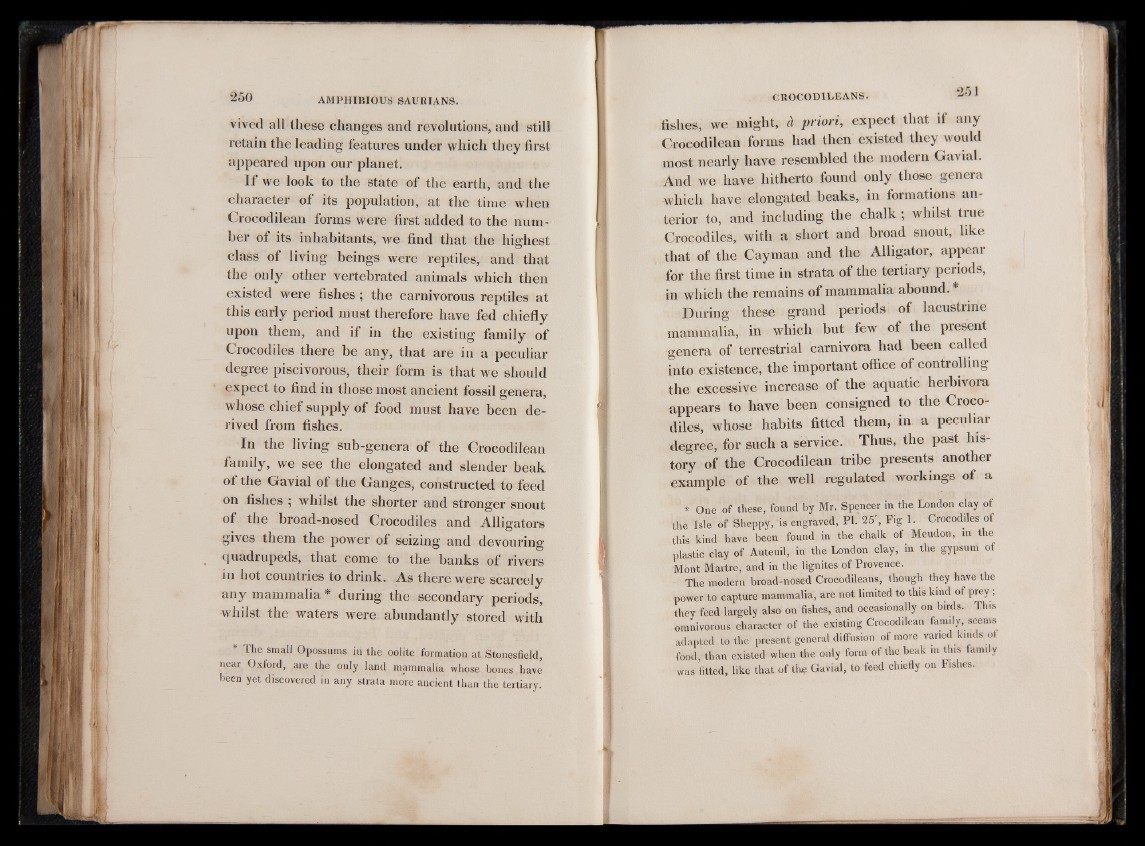
vived all these changes and revolutions, and still
retain the leading features under which they first
appeared upon our planet.
I f we look to the state of the earth, and the
character of its population, at the time when
Crocodilean forms were first added to the number
of its inhabitants, we find that the highest
class of living beings were reptiles, and that
the only other vertebrated animals which then
existed were fishes ; the carnivorous reptiles at
this early period must therefore have fed chiefly
upon them, and if in the existing family of
Crocodiles there be any, that are in a peculiar
degree piscivorous, their form is that we should
expect to find in those most ancient fossil genera,
whose chief supply of food must have been derived
from fishes.
In the living sub-genera of the Crocodilean
family, we see the elongated and slender beak
of the Gavial of the Ganges, constructed to feed
on fishes ; whilst the shorter and stronger snout
of the broad-nosed Crocodiles and Alligators
gives them the power of seizing and devouring
quadrupeds, that come to the banks of rivers
in hot countries to drink. As there were scarcely
any mammalia * during the secondary periods,
whilst the waters were abundantly stored with
The small Opossums in the oolite formation at Stonesfield,
near Oxford, are the only land mammalia whose bones have
been yet discovered in any strata more ancient than the tertiary.
fishes, we might, a priori, expect that if any
Crocodilean forms had then existed they would
most nearly have resembled the modern Gavial.
And we have hitherto found only those genera
which have elongated beaks, in formations anterior
to, and including the chalk; whilst true
Crocodiles, with a short and broad snout, like
that of the Cayman and the Alligator, appear
for the first time in strata of the tertiary periods,
in which the remains of mammalia abound. *
During these grand periods of lacustrine
mammalia, in which but few of the present
genera of terrestrial carnivora had been called
into existence, the important office of controlling
the excessive increase of the aquatic herbivora
appears to have been consigned to the Crocodiles,
whose habits fitted them, in a peculiar
degree, for such a service. Thus, the past history
of the Crocodilean tribe presents another
example of the well regulated workings of a
* One of these, found by Mr. Spencer in the London clay of
the Isle of Sheppy, is engraved, PI. 25', Fig 1. Crocodiles of
this kind have been found in the chalk of Meudon, in the
plastic clay of Auteuil, in the London clay, in the gypsum of
Mont Martre, and in the lignites of Provence.
The modern broad-nosed Crocodileans, though they have the
power to capture mammalia, are not limited to this kind of prey ;
they feed largely also on fishes, and occasionally on birds. This
omnivorous character of the existing Crocodilean family, seems
adapted to the present general diffusion of more varied kinds of
food, than existed when the only form of the beak in this family
was fitted, like that of the Gavial, to feed chiefly on Fishes.